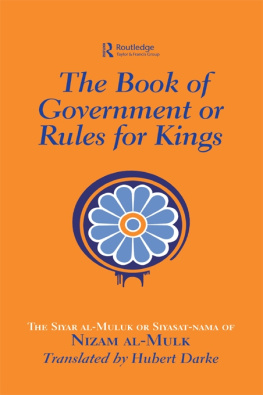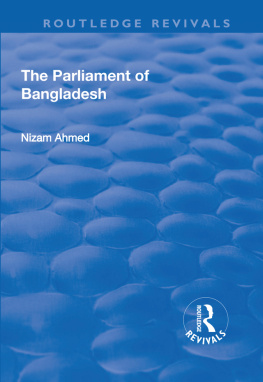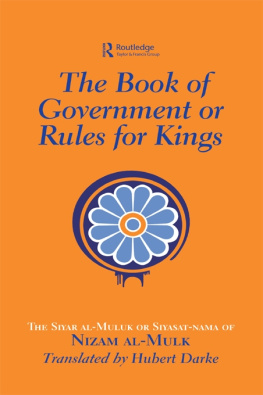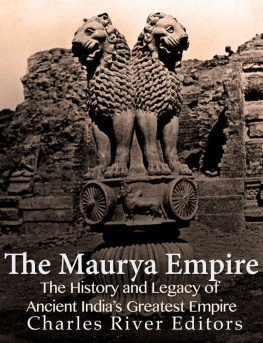The Book of Government
The Book of Government or Rules for Kings
The Siyar al-Muluk or Siyasat-nama of
NIZAM AL-MULK
Translated from the Persian by
HUBERT DARKE

First published in 1960
Second edition published in 1978
This edition published in 2002
by Routledge
2 Park Square, Milton Park, Abingdon, Oxon, OX14 4RN
270 Madison Ave, New York NY 10016
Transferred to Digital Printing 2006
www.routledge.com
2002 Persian Heritage Foundation
All rights reserved. No part of this book may be reprinted or reproduced or utilised in any form or by any electronic, mechanical, or other means, now known or hereafter invented, including photocopying and recording, or in any information storage or retrieval system, without permission in writing from the publishers.
British Library Cataloguing in Publication Data
A catalogue record of this book is available from the British Library
Library of Congress Cataloguing in Publication Data
A catalogue record for this book has been requested
ISBN 0700712283
Publishers Note
The publisher has gone to great lengths to ensure the quality of this reprint but points out that some imperfections in the original may be apparent
Contents
Introduction
The author
The book which is here offered to English readers was described by E. G. Browne as one of the most valuable and interesting prose works in Persian. It was written by asan ibn Al of s, entitled Nim al-Mulk, who for thirty years, first under Sultan Alp Arslan and then under his son Malikshh, as their chief minister directed the administration of the great empire of the Saljuqs. These Saljuqs were the ruling family of a tribe of wild Turkish nomads who, coming from the steppes of Central Asia, asked persmission from Suln Mamd of Ghazna to cross the Oxus in search of fresh pastures for their flocks in Khursn. They came and flourished, and soon became so strong that they were able to take Khursn from the Ghaznavids. The rise to power of the Saljuqs and the period of their ascendancy coincided exactly with the lifetime of Nim al-Mulk. He was born, according to two good authorities, either in 408 A.H./1018 A.D. (Mujmal-i Fa) or in 410 A.H./101920 A.D. (Trkh-i Baihaq); he died, as we know, in 485/1092, murdered by one of the assassins of the Ismals whom he denounced so fiercely in this book; thus he lived, and remained working, until a ripe old age. After his death, even to some extent because of it, the empire of the Saljuqs went into decline.
Not much is known about his early life. His father was a native of Baihaq, which is the old name for the town and district of Sabzvr; he had come to s as a tax-collector in the service of the Ghaznavids. In the Asrr at-Taud, which is a collection of anecdotes about the famous mystic, Shaikh Ab Sad ibn Abil-Khair, there are some glimpses of asan in his boyhood: on two occasions the Shaikh saw him and prophesied that he would become the khwja of the world; one was at s, when asan was a small boy, and the other was later when he was on his way to Marv to further his studies and stopped at Maihana to visit the Shaikh. He retained a great faith in the Shaikh and remained a nominal disciple all his life; he used to say that to him he owed all his success. Though not inclined to mysticism himself, in his later life he founded several hospices for the fs, and continued to support them financially. Politically more important was his promotion of orthodox religious education; he founded madrasas or colleges of higher learning in several cities; they were known as Nimiyyas after him, and the most famous of them were at Baghdad and Nishpr.
When Khursn fell to the Saljuqs with the defeat of Suln Masd in 431/1040, Hasans father went to Ghazna, taking his son with him. asan probably worked in the Ghaznavid administration for a time, but after a few years he left there and went back to Khursn to enter the service of the Saljuqs. Meanwhile, the Saljuq brothers, Tughril Beg and Chaghri Beg, had divided the dominion between them, Tughril taking the western half with his seat at Baghdad, and Chaghri remaining in the east with his headquarters at Marv. When Chaghri died in 452/1060 Tughril became paramount ruler and Chaghris son, Alp Arslan, succeeded him as governor of Khursn. Nim al-Mulk had for some years been adviser to Alp Arslan during the period that the latter had served his father in a subordinate command in eastern Khursn; he was now retained by Alp Arslan as his right-hand man, and thus, until the death of Tughril in 455/1063, he was responsible for the administration of the whole of Khursn. It was during this period that enmity grew up between him and Tughrils vazir, Amd al-Mulk al-Kundur. Tughril had no male heir, and Kundur had persuaded Tughril to designate Sulaimn, Chaghris younger son, to succeed him, knowing full well that if Alp Arslan, the elder son of Chaghri, became great sultan, it would be Nim al-Mulk who became khwja of the world rather than Kundur himself. Eventually Alp Arslans succession was secured and Kundur was sent into exile and a little later executed, no doubt on the orders of Nim al-Mulk.
During the reigns of Alp Arslan (45565/106373) and his son Malikshh the Saljuq power reached its zenith and Nim al-Mulk was at the height of his career. The empire covered a vast territory extending from the borders of Afghanistan to the shores of the Mediterranean, and as head of the administration Nim al-Mulk acquired great authority and prestige. When Malikshlh came to the throne he was only eighteen years of age and at first he relied heavily on his vazir. Thus Nim al-Mulk was able to have his own way for a number of years, and there is no doubt that he directed affairs with great skill and efficiency. E-Iowever, his manner was not without arrogance; his habit of putting his friends and relations into the best posts began to arouse resentment, and his opponents were able to gain the ear of the sultan. As the sultan increased in maturity he asserted himself more vigorously, and there were times when he was on bad terms with his vadr. Perhaps it was at such a moment, when he was dissatisfied with the state of things in his kingdom and tempted to consider ways of replacing him, that he commanded Nim al-Mulk and several others to compose treatises on the art of government. What the others wrote, if anything, we shall never know; what survives is the book before us the memorial of a great Iranian statesman.
The Nakhjivn MS of Tabrz
Until the discovery of this MS it could be said that the text of this book had been badly preserved. Not one of the dozen or so extant MSS gave a satisfactory text; not only did they contain Alp Arslan, we can be more confident overall that the book is the genuine composition and compilation of Nim al-Mulk.
Title
Since Charles Schefer published the Persian text (1891) and the French translation (1893), this book has been generally known in Europe as the Siysat-nma, and accordingly the present translation retains the title The Book of Government. However, all MSS give the him.
Numbering of chapters
All MSS shew confusion in the numbering of chapters in the body of the text; this is resolved by referring to the list of contents at the beginning of the book. Errors crept into the text when scribes came to the heading of a fresh section within a chapter (such as suits the beginning of a new section; so we are justified in indicating the division of the book into two parts accordingly.
Hajj Khalfa, the great eleventh/seventeenth century Turkish bibliographer, gives a description of the book which is faulty in some details; the entry in his
Next page









